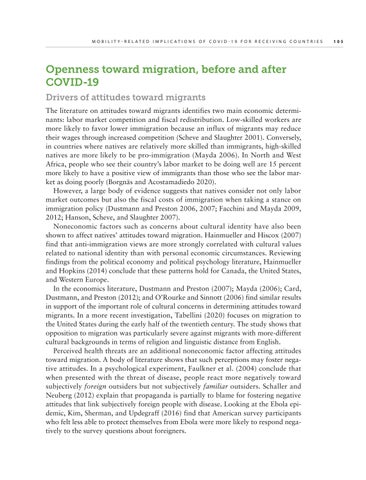M o b i l i t y - R e l a t e d I m p l i ca t i o n s o f C OVID - 1 9 f o r R e c e i v i n g C o u n t r i e s
Openness toward migration, before and after COVID-19 Drivers of attitudes toward migrants The literature on attitudes toward migrants identifies two main economic determinants: labor market competition and fiscal redistribution. Low-skilled workers are more likely to favor lower immigration because an influx of migrants may reduce their wages through increased competition (Scheve and Slaughter 2001). Conversely, in countries where natives are relatively more skilled than immigrants, high-skilled natives are more likely to be pro-immigration (Mayda 2006). In North and West Africa, people who see their country’s labor market to be doing well are 15 percent more likely to have a positive view of immigrants than those who see the labor market as doing poorly (Borgnäs and Acostamadiedo 2020). However, a large body of evidence suggests that natives consider not only labor market outcomes but also the fiscal costs of immigration when taking a stance on immigration policy (Dustmann and Preston 2006, 2007; Facchini and Mayda 2009, 2012; Hanson, Scheve, and Slaughter 2007). Noneconomic factors such as concerns about cultural identity have also been shown to affect natives’ attitudes toward migration. Hainmueller and Hiscox (2007) find that anti-immigration views are more strongly correlated with cultural values related to national identity than with personal economic circumstances. Reviewing findings from the political economy and political psychology literature, Hainmueller and Hopkins (2014) conclude that these patterns hold for Canada, the United States, and Western Europe. In the economics literature, Dustmann and Preston (2007); Mayda (2006); Card, Dustmann, and Preston (2012); and O’Rourke and Sinnott (2006) find similar results in support of the important role of cultural concerns in determining attitudes toward migrants. In a more recent investigation, Tabellini (2020) focuses on migration to the United States during the early half of the twentieth century. The study shows that opposition to migration was particularly severe against migrants with more-different cultural backgrounds in terms of religion and linguistic distance from English. Perceived health threats are an additional noneconomic factor affecting attitudes toward migration. A body of literature shows that such perceptions may foster negative attitudes. In a psychological experiment, Faulkner et al. (2004) conclude that when presented with the threat of disease, people react more negatively toward subjectively foreign outsiders but not subjectively familiar outsiders. Schaller and Neuberg (2012) explain that propaganda is partially to blame for fostering negative attitudes that link subjectively foreign people with disease. Looking at the Ebola epidemic, Kim, Sherman, and Updegraff (2016) find that American survey participants who felt less able to protect themselves from Ebola were more likely to respond negatively to the survey questions about foreigners.
105

